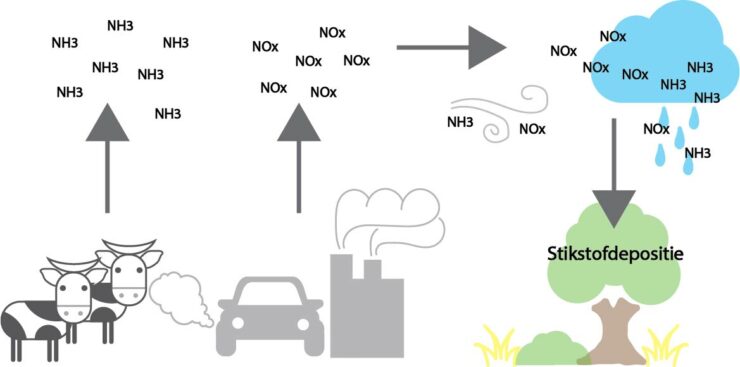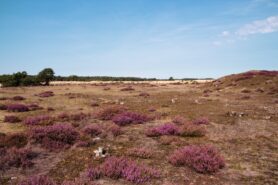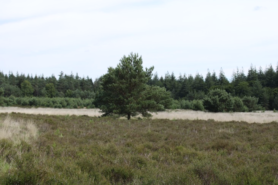The Circle of Life
Researchers predict the future of Dutch nature
While the world is struggling with the invisible Covid-19 virus, nature is dealing with invisible nitrogen gases as well. Nitrogen gases, such as nitrogen oxides and ammonia, are very harmful to the environment and cause various plant species to disappear. Can you imagine that in a few decades we might be walking in a forest without trees? Wageningen University predicts what will happen to our nature in the future.
It is precisely in this time of Covid-19 that we enjoy nature even more. When the weather permits, we go out and we want to keep doing that. The Netherlands has many different types of nature: forests, polders, rivers, dunes and the sea. Here plants and animals live together in an area with a physical environment, such as sunlight, soil, water and air. We call one such area an ecosystem.
It is important that an ecosystem remains in balance. This means that all plant and animal species present in an ecosystem remain roughly the same. Ecosystems in the Netherlands are currently not doing well. We have a surplus of nitrogen gases, which seriously affects our nature.
Nitrogen problem in the Netherlands
About 80% of the air consists of nitrogen (N2). This is harmless to humans and the environment. When N2 reacts with oxygen in a combustion reaction, nitrogen oxides (NOx) are formed. (Car) engines and industry produce this NOx. In addition, cows produce the gas ammonia (NH3), which is a reaction of N2 with hydrogen in cow manure. These NOx and NH3 (hereinafter referred to as “nitrogen gases”) are much more harmful to the environment when they are emitted to a high degree.
The nitrogen gases that have entered the air are carried by the wind. It is possible that the gases end up above nature reserves. Plants convert part of the nitrogen gases into nitrate and use this as a nutrient for growth. The rest remains in the air. The gases can reach the ground via the wind or rain. This is called nitrogen deposition (see Figure 1).

Image 1: Nitrogen gases are emitted by traffic, industry and agriculture. The gases are carried by the wind and eventually end up on and in the soil. This is called nitrogen deposition (stikstofdepositie in Dutch).
What does nitrogen do to our nature?
You can clearly see the effect of nitrogen deposition in nature. Do you ever go to the forest? Then take a good look at the landscape. The nitrogen gases that penetrate into the soil acidify the soil. Grasses and weeds like a nitrogen-rich soil and grow very fast. As a result, rare plant species disappear and that creates a monotonous landscape.
In the Veluwe we see that a diverse landscape has been exchanged for brown grassy plains (see image 2). Plants and trees die. Insects lose habitat and disappear, leaving birds without food. A reduction in the number of insects also affects us! Insects pollinate crops on which fruit grows, such as apple trees. Without insects we could produce much less food! If one component in the ecosystem changes (acidification of the soil in the Veluwe), this has an effect on many other links, inside (insects) and outside (food production and people) the ecosystem.


Image 2: Changing landscape in the Veluwe. Dry brown grassy plains take over the varied landscape (left, photo @ Thijs Tuynman of Pexels). Some shrubs with flowers stand on a dead landscape. Pine trees grow well in nitrogen-rich soils, oak trees are disappearing (photo right, @ Solée Pop).
PROPS
Nitrogen deposition is an increasing problem in the Netherlands. Nature is changing and political measures must be taken for this. But how do we know what to do to tackle the nitrogen problem? The University of Wageningen (WUR) is researching the effect of a new measure on plant growth throughout Europe. It investigates uses a calculation program called PROPS.
Researcher and ecologist at WUR Wieger Wamelink explains: “With PROPS we collect data from all over Europe, including the Netherlands. We look at what would happen to plant growth in Europe if we emitted less nitrogen gases. We draw up advice based on these measurements. For example, we can predict what will happen if we reduce the number of cows in the Netherlands and whether this will have a positive effect. The government then decides whether or not to do something with it”, says Wamelink. “But we also look at global warming. It has already risen by about +1.5 degrees. We have calculated that if the temperature rises to +3 degrees, then 30% of the plant species will have disappeared!”
Soil research in Europe
Researchers conduct soil research throughout Europe. They plot an area of 2m2 and count how many different plant species there are. To see how healthy the soil is, researchers send soil samples to the laboratory. Lab technicians in different countries look at the amount of nitrogen, acidity, potassium, calcium and magnesium in the soil. These data are processed in PROPS.
Last year we saw that during the Covid-19 lockdown, nitrogen emissions were drastically reduced. Can PROPS also make a statement about what would happen if we were to receive online lessons more often after the Covid-19 pandemic? Wamelink explains: “Yes, we can. Then nitrogen gas emissions would decrease and global warming would be less. Especially if we were to apply this worldwide. ”
“PROPS calculates what will happen if we reduce the number of cows in the Netherlands by half. We can then show what effect that has and whether it has a positive effect ”- says Wamelink.
We humans can now get a vaccine against Covid-19, but nature also needs to be protected from nitrogen gases. As Mufasa tells Simba that we are all part of “the cycle of life,” we as humans also have a huge influence on the course of ecosystems. If one component becomes unbalanced, it has an effect on the entire ecosystem and outside. With PROPS we can predict what will happen to nature in the future. Let’s hope this future looks rosy. Because, a forest is not a forest without trees, is it?

